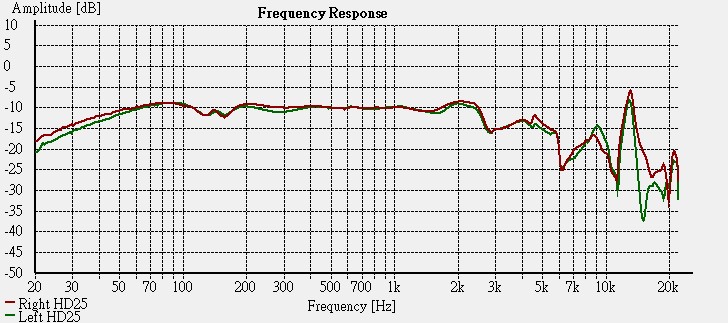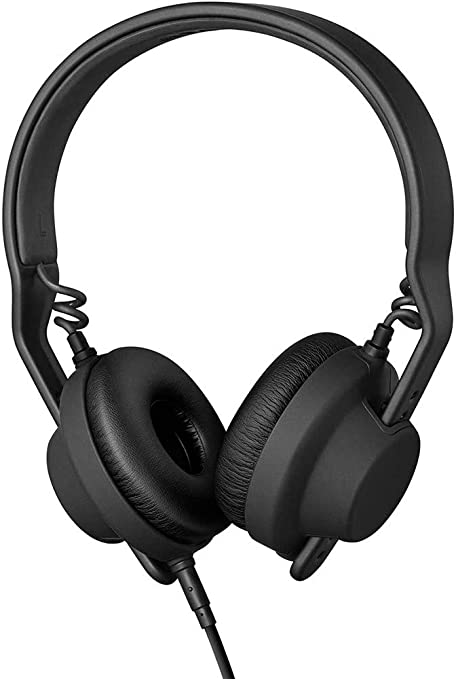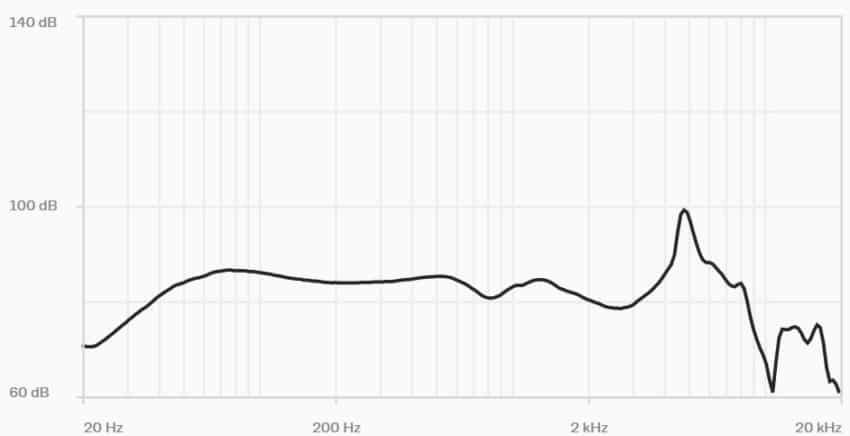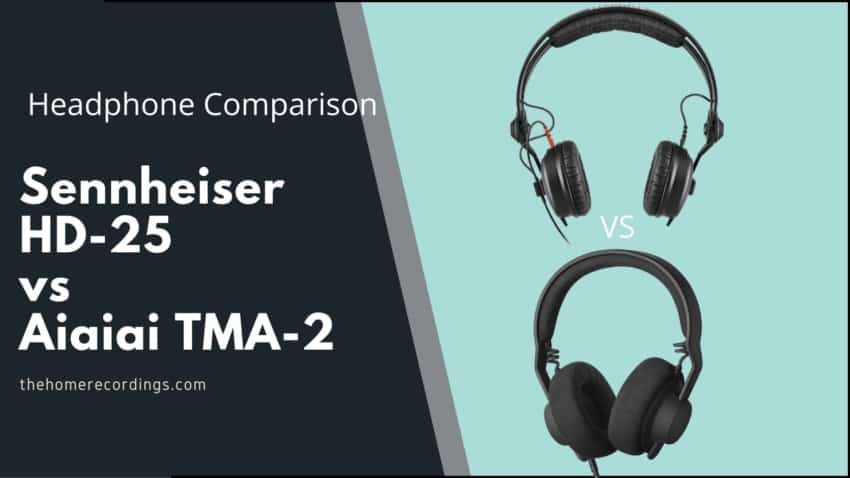Last updated on December 30th, 2023 at 02:57 pm
When I am performing music live or DJing, two pairs of headphones that I often compare are the Sennheiser HD25’s and the Aiaiai TMA-2s’. Both are great options for DJing, but each for different reasons.
If you have ever wondered which pair comes up on top, keep reading – I am going to be putting them head-to-head.
Which is better, the Sennheiser HD25’s or the Aiaiai TMA-2’s? The Sennheiser HD25’s are on-ear headphones with a high contact pressure of 2.5N and thus excellent at blocking out background noise, making them a solid choice for DJing or monitoring in loud environments, while the modular and customizable design of the Aiaiai TMA-2 provides flexibility for any listening scenario.
Sennheiser HD-25

The Sennheiser HD-25’s are on-ear headphones aimed towards the target audience of DJs due to their key focus on monitoring live audio. A few years back I was struggling to find a pair of headphones that would successfully block background noise when I was DJing. The HD25’s have a high on-ear pressure of 2.5N, and these headphones finally presented a solution to the issues that I was facing without the need for noise-cancelling software.
Until recently I had not used any other pair of headphones for live performance, and this is all down to the style and build of the headphones as opposed to the audio tech inside them.
The frequency range of the HD-25’s is 16 – 22000Hz, generally providing very satisfying sound quality even outside of a DJ setting. The bass feels powerful and the high-end is very clear, making them a great pair of headphones for tasks outside of DJing too.

However, they do compromise when it comes to comfort. After wearing them for over half an hour, my ears will begin to feel sore and cramped regardless of the volume.
My favorite thing about these headphones (the high on-ear pressure) is ultimately also its downfall due to the discomfort of this feature, although this is a compromise that I am willing to take when DJing.
When I first saw the HD25’s I thought they looked rather weak and easily breakable due to the thin build and exposed wiring. However, this could not be further from the case – my pair have been used excessively in travel and DJ scenarios, yet they still feel like they are good as new. I am also very fond of the flexible build these headphones have, allowing me to rotate the earcups 90 degrees vertically which is ideal for single-ear DJing.
What comes in the Box?
- Sennheiser HD-25 Headphones
- 1.5m Audio Cable
- Manual
Specifications
| Style | On-ear |
| Frequency Response (Hz) | 16 – 22000 |
| Connectivity | Wired |
| Impedance (Ω) | 36.0 |
| Total Harmonic Distortion | 0.3% |
| Maximum Input Power (mW) | 200mm |
| Connector | 3.5mm |
Find out more about the Sennheiser HD25 here:
- Sennheiser HD25: Amazon, Sweetwater.
Aiaiai TMA-2

The Aiaiai TMA-2 headphones are rather unique in that they are not just a pair of headphones but a set of modular components that can be used to build a customized pair of headphones.
The product range includes preset designs specifically created for certain purposes (such as the ‘studio’ preset or the ‘comfort’ preset), but individual modules can also be hand-picked on their website to craft the perfect pair.
Considering that I am a DJ, I recently went ahead and bought the Aiaiai TMA-2 DJ preset, but it’s very interesting how the company has approached the design of these. Due to the discomfort of my HD25’s I decided to buy a second pair of ‘comfort’ earcups that I could swap out in case the DJ earcups became uncomfortable.
I have not been able to locate the exact figure for the on-ear pressure for these headphones, but I can only assume that it is around the same as the HD25s (2.5N).
The headphones generally feel similar to the Sennheiser’s, and once again block out the noise of a loud DJ environment whilst unfortunately presenting a fair level of discomfort. This is inevitable and an unavoidable problem, but it feels great to be able to swap out the DJ earcups for the comfort earcups when I am using the headphones for general listening and studio purposes.
In terms of the frequency response, it must be said that the TMA-2’s do not perform quite as well as the HD25’s with a range of 20 – 22hz (thus the lowest frequency is 4hz higher than the HD25’s).

However, this is hardly noticeable for the purposes that I use them for, and the bass always feels nice and subby and the treble is perceived as crisp and clear. It is also worth noting that the headphone cups do not rotate as they do with the Sennheiser’s, but this only demonstrates how that feature was a little bit of a gimmick as I can simply move a headphone behind my ear.
What comes in the Box?
- H02 Headband
- C02 Audio Cable
- E02 Earpads
- S02 Drivers
- Manual
Specifications
| Style | On-ear |
| Frequency Response (Hz) | 20 – 22000 |
| Connectivity | Wired |
| Impedance (Ω) | 32.0 |
| Total Harmonic Distortion | N/A |
| Maximum Input Power (mW) | 70 |
| Connector | 3.5mm |
Find out more about the Aiaiai TMA-2 here:
- Aiaiai TMA-2: Amazon.
Main Differences
The main difference between the two pairs of headphones is the way that the Aiaiai’s are modular. The DJ preset is very much a similar pair to the HD25’s (albeit with a slightly lower frequency range), but when paired with an alternative earcup module such as the ‘comfort’ earcup, this presents opportunities for great flexibility.
This does result in the HD-25’s being a much cheaper option, with the Aiaiai’s greater versatility resulting in the potential for a significantly higher price tag.
Conclusion
Overall, the Sennheiser HD-25’s and the Aiaiai TMA-2 DJ Preset are both excellent headphones for DJing that block out plenty of background noise and excel at monitoring audio whilst inevitably being slightly uncomfortable.
However, the modular and customizable approach to the TMA-2 is highly appealing by offering versatile alternatives for different listening scenarios (such as when I wanted to use them for comfortable listening or studio engineering).
Whilst it must be said that the TMA-2’s are slightly weaker in terms of frequency response, I don’t think this matters too much as long as you are not a professional mixing/mastering engineer.
Ultimately the versatility of the TMA-2 wins here for me, it’s exactly what I needed to offer a compromise on the excellence yet lack of comfort that the HD-25s offer.
